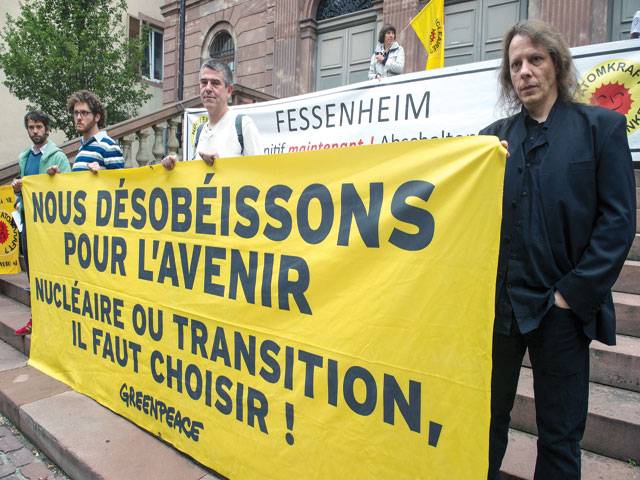STRASBOURG, France : Fifty-five Greenpeace activists from some 20 countries go on trial in France on Thursday for an audacious break-in at the country’s oldest nuclear power plant to highlight weaknesses at atomic installations.
The March 18 protest at the Fessenheim power plant in eastern France near the border with Germany and Switzerland resulted in the government ordering stronger security at nuclear facilities.
The activists include 21 Germans, seven Italians and others from France, Turkey, Austria, Hungary, Australia and Israel and several other nations.
The court in the eastern French city of Colmar will try and determine whether the Greenpeace members had smashed a metal security gate with their truck to enter the plant or simply broken a lock to get in as they claim.
They will be tried for trespassing and for wilful damage and could be slapped with a prison term of up to five years if convicted.
Those activists from countries outside the European Union’s 26-nation Schengen visa-free travel zone also face a travel ban in France if convicted.
However, protestors staging break-ins at French nuclear installations in the past have got off with six-month suspended prison sentences.
The March dawn protest ended hours later at the plant run by state-run power firm EDF. About 20 activists had managed to get on the dome of one of the reactors but EDF said the safety of the plant had not been compromised.
Later another group of Greenpeace activists put up a giant banner next to the nearby Rhine canal, which read “Future Is Renewable, Stop Nuclear”.
France, the world’s most nuclear-dependent country, operates 58 reactors and has been a leading international proponent of atomic energy.
But in a deal with the Greens before the 2012 parliamentary and presidential elections, President Francois Hollande’s Socialist party promised to cut reliance on nuclear energy from more than 75 percent to 50 percent by shutting 24 reactors by 2025.
Hollande has pledged to close Fessenheim, which was commissioned in 1977, by the end of 2016.
The plant, located on the banks of the Rhine, is considered vulnerable to seismic activity and flooding.
The protest stunt came ahead of a meeting by European leaders to discuss the future of the continent’s energy policy.
Greenpeace wants Hollande and German Chancellor Angela Merkel to push Europe towards cleaner energy, complaining that France relies too much on nuclear power and Germany on coal for electricity supplies.
Hollande has repeatedly pledged to develop renewable energy and vowed to improve the energy efficiency of one million homes that are badly insulated.
France plans to reach the EU’s 10 percent renewable energy target by boosting the use of second-generation biofuels, which are made from crop residues, waste, algae or woody material.
Friday, April 19, 2024
Greenpeace members on trial for daring N-break-in

Caption: Greenpeace members on trial for daring N-break-in
KP minister briefed on issues about sales tax on services
April 19, 2024
64th anniversary of freedom fighter Mirzali Khan marked
April 19, 2024
893,000 students appear in SSC exams in KP
April 19, 2024
Saudi govt shows interest to fund two road projects
April 19, 2024
Moot notes diabetes, blood pressure on the rise among youth
April 19, 2024
Hepatitis Challenge
April 18, 2024
IMF Predictions
April 18, 2024
Wheat War
April 18, 2024
Rail Revival
April 17, 2024
Addressing Climate Change
April 17, 2024
Justice denied
April 18, 2024
AI dilemmas unveiled
April 18, 2024
Tax tangle
April 18, 2024
Workforce inequality
April 17, 2024
New partnerships
April 17, 2024
ePaper - Nawaiwaqt
Advertisement
Nawaiwaqt Group | Copyright © 2024





